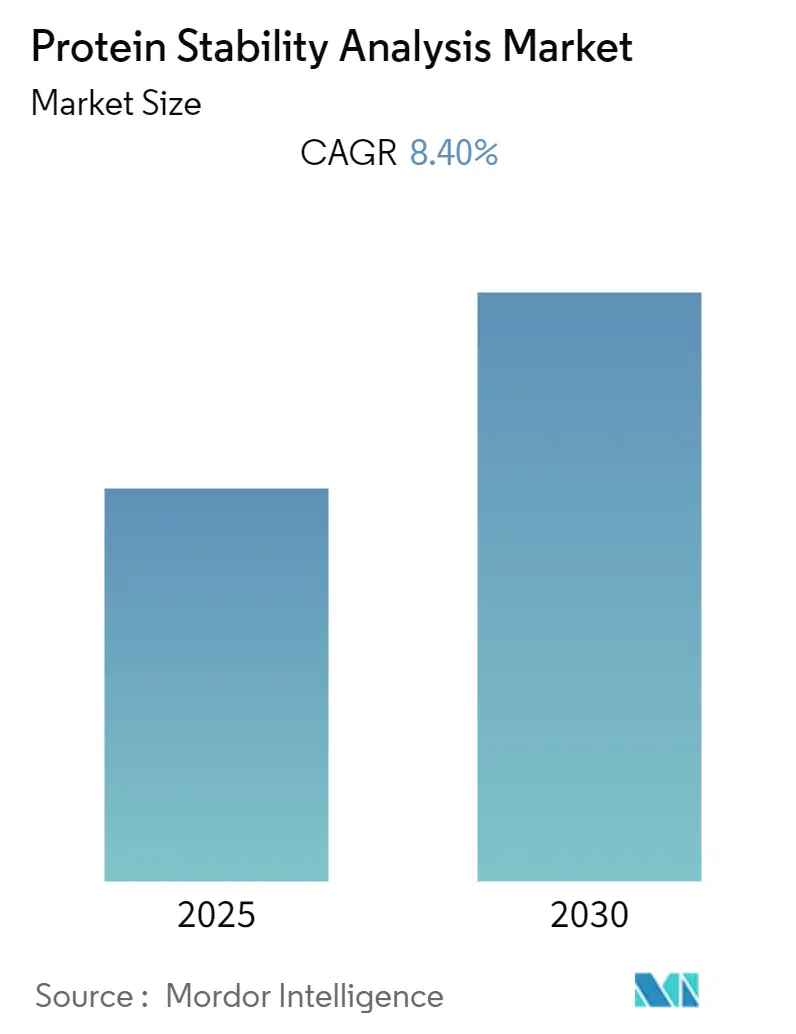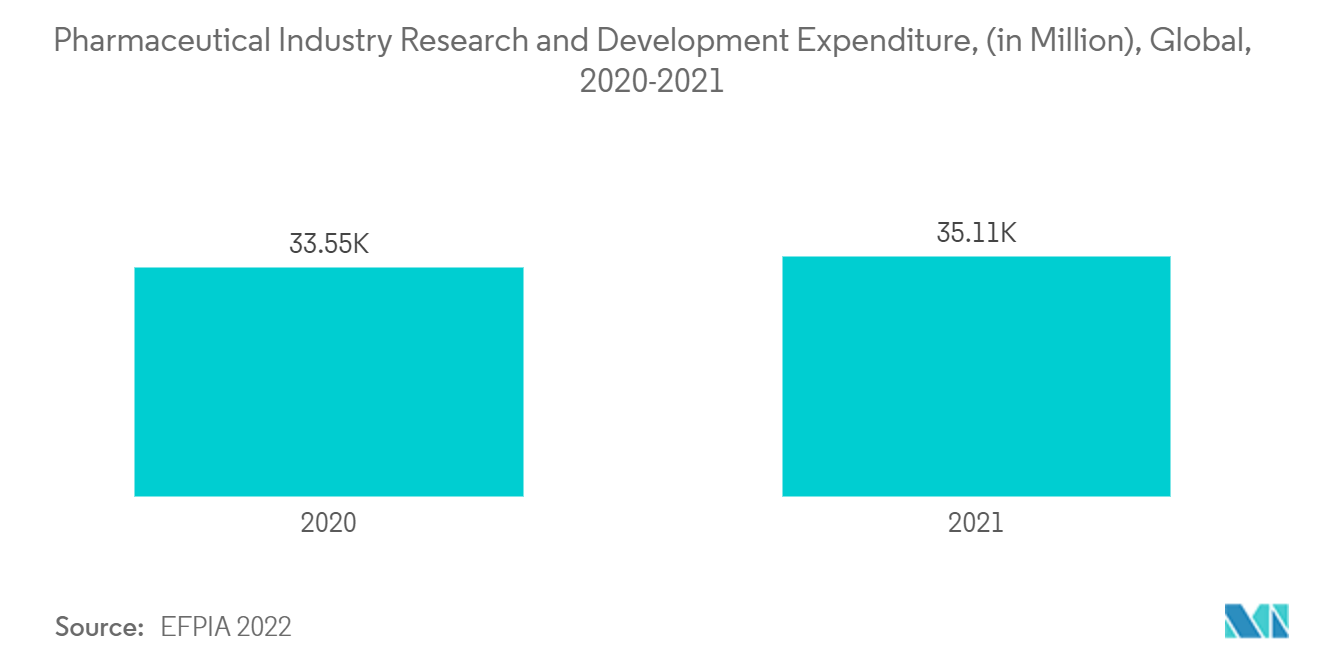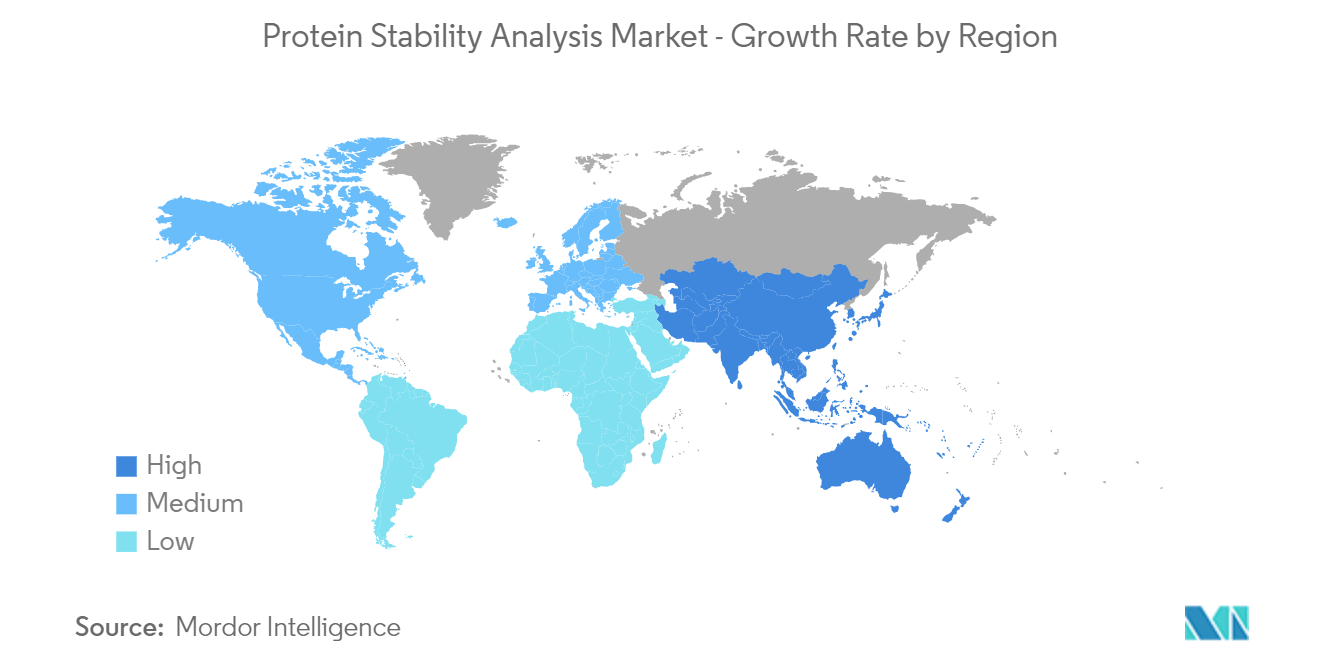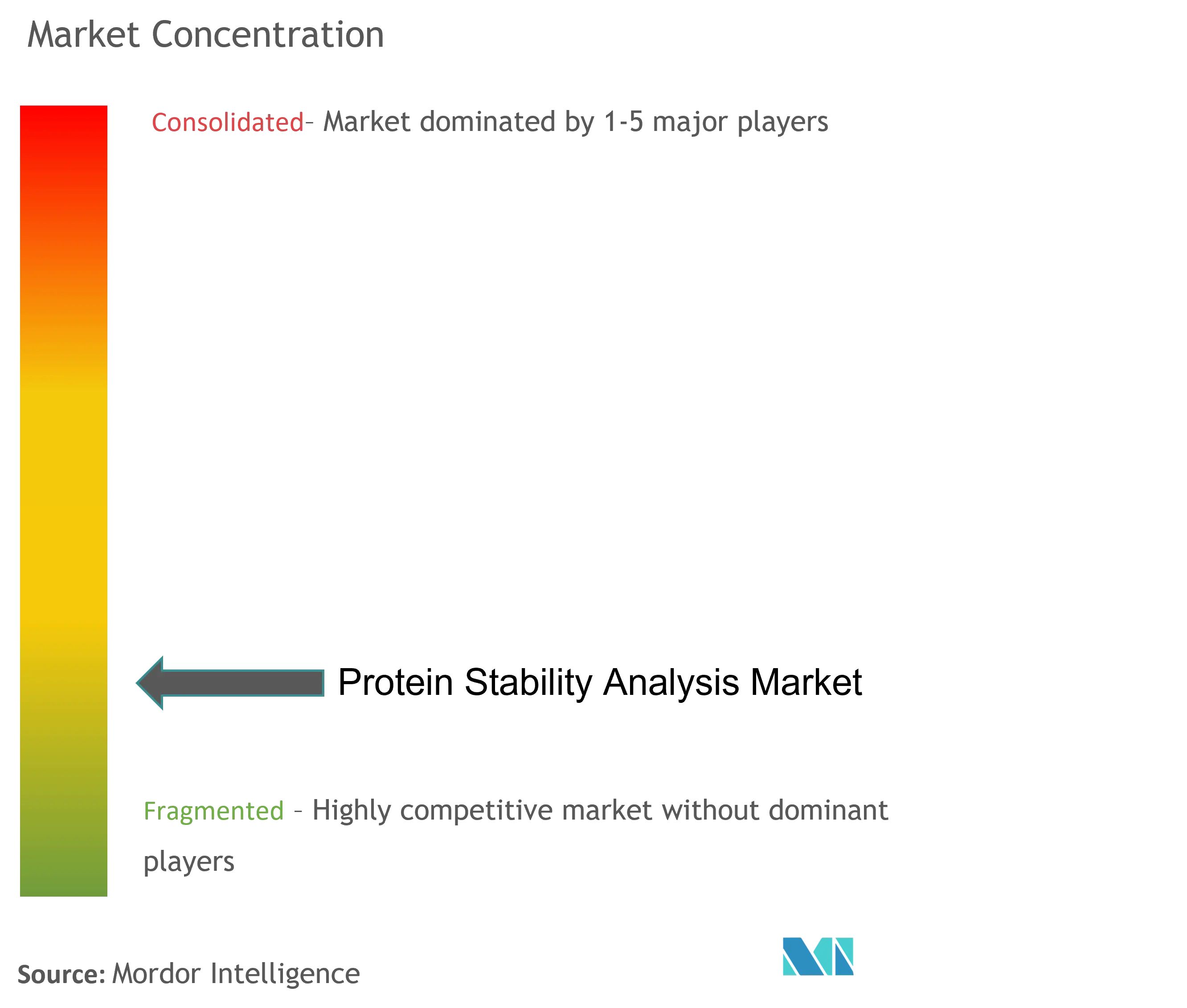Protein Stability Analysis Market Size and Share

Protein Stability Analysis Market Analysis by Mordor Intelligence
The Protein Stability Analysis Market is expected to register a CAGR of 8.4% during the forecast period.
COVID-19 had a significant impact on the protein stability analysis market in the initial phase since protein stability studies were conducted to assess the structure and nature of the COVID-19 virus to a great extent which helps gain a better understanding of the virus and supports the development of effective and efficient therapeutics. For instance, as per the article published in September 2022 in Stanford Medicine, elevated virus levels in the blood of COVID-19 patients in hospitals predicted the worsening of respiratory symptoms and suggest ongoing viral replication in advanced disease stages. A protein of the virus that causes COVID-19 was measured in the patient's blood during the test. Hence, such analysis showing the complications associated with COVID-19 through protein analysis will likely boost the market growth.
In the post-pandemic era, studies are still being conducted due to the emergence of different COVID-19 mutants. Since the beginning of the pandemic, the WHO has described eight variants of interest (VOIs), namely Epsilon, Zeta, Eta, Theta, Iota, Kappa, Lambda, and Mu. Currently, studies are being conducted to determine whether mutants of Omicron variants affect the virus's properties, speed of spreading, the severity of the associated disease, the performance of vaccines, or other public health and social measures and hence, the demand for protein analysis products is expected to increase. Another factor to account for are the Sars-COV-2 strains which are expected to have a positive impact on the market over the forecast period.
Factors such as rising research and development expenditure of pharmaceutical and biopharmaceutical companies, increasing proteomics and genomics research activities, and an increasing number of recombinant protein therapeutics and biologics are expected to drive the market growth over the forecast period since research studies require protein stability assessments to substantiate the results.
For instance, as per the EFPIA 2022 report, in 2021, Europe invested an estimated EUR 41,500 million (about USD 35,109 million) in pharmaceutical R&D. Thus, huge investments in R&D drive the growth of the protein stability analysis market during the forecast period. Furthermore, investments and financing in genomic research activities are projected to fuel the market as researchers seek opportunities in protein stability studies. For instance, in September 2022 NHGRI, part of the NIH, planned to fund USD 3.35 million over five years to launch the Genome Research Experiences to attract researchers into the Genomics Field to Enhance Diversity (GREAT) program. Moreover, in September 2022, a joint venture by the University of Western Australia and Proteomics International, which conducts vital work in medical, environmental, and agricultural testing of proteins received a funding of USD 2 million . The money is likely to enable the WA Proteomics Facility to upgrade its automated tools and staff, increasing output capacity to hundreds of samples.
As a result of the increase in pharmaceutical and biopharmaceutical companies' R&D expenditures, as well as the increase in the number of proteomics and genomics research activities, the protein stability analysis market is anticipated to witness growth over the forecast period. However, the high cost of protein stability analysis systems is expected to restrain the growth of this market to a certain extent.
Global Protein Stability Analysis Market Trends and Insights
Differential Scanning Calorimetry (DSC) is Expected to Hold a Significant Share Over the Forecast Period
The differential scanning calorimetry technique has been widely used in characterizing the stability of proteins in their native form by measuring the heat required to denature a particular biomolecule, like a protein. This technique determines molecules with higher thermal transition midpoints, which are considered more stable than those with lower transition midpoints. This technique is widely used in research & development and drug discovery. The DSC segment is likely to witness growth over the forecast period due to the wide advantages of DSC such as the ease and speed with which it can be used to see transitions in materials. Due to this reason, DSC is preferred over other techniques to scan and identify proteins.
The research and development in the field of protein stability using differential scanning calorimetry are driving the market growth as it showcases the ease and speed of DSC for research. According to an article published in June 2022 in the Biosensors journal, a study demonstrated the direct thermal characterization of protein samples using a new micro-electromechanical system (MEMS)-based differential scanning calorimeter (DSC). With high throughput, the MEMS calorimeter could screen many therapeutic proteins for conformational stability based on transition temperature. Hence, such advancements in DSC associated with protein analysis are likely to boost market growth over the forecast period. The importance of research and development (R&D) for the pharmaceutical industry is evidenced by the cumulative R&D expenditure in the sector. It has been observed that R&D spending is increasing each year and several pharma and biotech companies are focusing on strengthening their R&D facilities which are ultimately driving the growth of the market studied. The spending on research and development (R&D) by various pharmaceutical companies and government organizations has been increasing recently in the United States, which is anticipated to drive market growth over the forecast period. For instance, as per the 2022 report from EFPIA, in 2021 North America accounted for 49.1% of world pharmaceutical sales compared with 23.4% for Europe. As the R&D expenditure and sales increase, the demand for protein stability analysis techniques like DSC is expected to increase thereby boosting the market growth.

North America is Expected to Dominate the Market During the Forecast Period
The presence of well-established research and development institutions and their high investment in the region is driving market growth over the forecast period since the research initiatives are likely to utilize protein stability studies for accurate results. For instance, as per the Statistics Canada June 2022 report, in-house spending on R&D in 2021 was expected to grow by 3.5%, reaching USD 23.4 billion. Companies expect more modest growth in their in-house R&D spending in 2022, with total R&D spending anticipated to increase by 1.7% to USD 23.8 billion.
Furthermore, investments by the government and private companies in genomic and proteomic research are likely to drive market growth in the North American region. For instance, in February 2021, through a merger, Seattle-based Nautilus Biotechnology entered the public market and received USD 350 million to accelerate the development of its protein analysis technology for drug discovery and diagnostic applications. Moreover, in September 2022, Stanford University Mass Spectrometry Proteomics Seed Grants provided a research grant of USD 10,000 to researchers aiming for new mass spectrometry projects and new methodologies taking advantage of the capabilities of recently added research instrumentation.
Additionally, genomic as well as proteomic research works in the North American region promote market growth since they identify the need for protein stability study and utilize the reagents and equipment associated with stability studies. For instance, as per the article published in May 2022 by MDPI which was supported by the National Institute of Respiratory Diseases 'Ismael Cosío Villegas,' Mexico, a study showed that proteomics has enabled the identification of novel allergens that can be used in serodiagnosis and has made it possible to analyze thousands of proteins in a single analysis.

Competitive Landscape
The protein stability analysis market is fragmented in nature due to the presence of several companies operating globally as well as regionally. The competitive landscape includes an analysis of a few international and local companies that hold market shares and are well-known. These include Agilent Technologies Inc, NanoTemper Technologies, Shimadzu Corporation, Thermo Fisher Scientific, and Spectris PLC (Malvern Panalytical Ltd).
Protein Stability Analysis Industry Leaders
-
Agilent Technologies Inc
-
NanoTemper Technologies
-
Shimadzu Corporation
-
Thermo Fisher Scientific
-
Spectris PLC (Malvern Panalytical Ltd)
- *Disclaimer: Major Players sorted in no particular order

Recent Industry Developments
- In June 2022, Agilent Technologies launched new liquid chromatography-mass spectrometry (LC-MS) and gas chromatography-mass spectrometry (GC-MS) quadrupole mass spectrometers that the company said will raise the level of built-in instrument intelligence and offer a higher level of instrument diagnostics to maximize system uptime for customers.
- In April 2022, Linseis Messgeräte GmbH received a patent for its Chip-DSC. The result of this development is a small, easy-to-use, and cost-effective measuring cell for a full-fledged differential scanning calorimeter.
Global Protein Stability Analysis Market Report Scope
As per the scope of the report, protein stability is the net balance of forces, which determines whether a protein will be its native folded conformation or a denatured (unfolded or extended) state. Protein stability analysis instruments are used to determine protein stability. The Protein Stability Analysis Market is segmented by Product (Reagents and Assay Kits, Instruments, Consumables and Accessories, and Others), Technique (Chromatography, Spectroscopy, Surface Plasmon Resonance, Differential Scanning Calorimetry, Differential Scanning Fluorimetry, and Other Techniques), End-User (Pharmaceutical & Biotechnology Companies, Academic and Research Organizations) and Geography (North America, Europe, Asia-Pacific, Middle East, and Africa, and South America). The market report also covers the estimated market sizes and trends for 17 countries across major regions globally. The report offers the value (in USD million) for the above segments.
| Reagents and Assay Kits |
| Instruments |
| Consumables and Accessories |
| Other Products |
| Chromatography |
| Spectroscopy |
| Surface Plasmon Resonance |
| Differential Scanning Calorimetry |
| Differential Scanning Fluorimetry |
| Other Techniques |
| Pharmaceutical & Biotechnology Companies |
| Academic and Research Organizations |
| North America | United States |
| Canada | |
| Mexico | |
| Europe | Germany |
| United Kingdom | |
| France | |
| Italy | |
| Spain | |
| Rest of Europe | |
| Asia-Pacific | China |
| Japan | |
| India | |
| Australia | |
| South Korea | |
| Rest of Asia-Pacific | |
| Middle East and Africa | GCC |
| South Africa | |
| Rest of Middle East and Africa | |
| South America | Brazil |
| Argentina | |
| Rest of South America |
| By Product | Reagents and Assay Kits | |
| Instruments | ||
| Consumables and Accessories | ||
| Other Products | ||
| By Technique | Chromatography | |
| Spectroscopy | ||
| Surface Plasmon Resonance | ||
| Differential Scanning Calorimetry | ||
| Differential Scanning Fluorimetry | ||
| Other Techniques | ||
| By End-User | Pharmaceutical & Biotechnology Companies | |
| Academic and Research Organizations | ||
| Geography | North America | United States |
| Canada | ||
| Mexico | ||
| Europe | Germany | |
| United Kingdom | ||
| France | ||
| Italy | ||
| Spain | ||
| Rest of Europe | ||
| Asia-Pacific | China | |
| Japan | ||
| India | ||
| Australia | ||
| South Korea | ||
| Rest of Asia-Pacific | ||
| Middle East and Africa | GCC | |
| South Africa | ||
| Rest of Middle East and Africa | ||
| South America | Brazil | |
| Argentina | ||
| Rest of South America | ||
Key Questions Answered in the Report
What is the current Protein Stability Analysis Market size?
The Protein Stability Analysis Market is projected to register a CAGR of 8.4% during the forecast period (2025-2030)
Who are the key players in Protein Stability Analysis Market?
Agilent Technologies Inc, NanoTemper Technologies, Shimadzu Corporation, Thermo Fisher Scientific and Spectris PLC (Malvern Panalytical Ltd) are the major companies operating in the Protein Stability Analysis Market.
Which is the fastest growing region in Protein Stability Analysis Market?
Asia Pacific is estimated to grow at the highest CAGR over the forecast period (2025-2030).
Which region has the biggest share in Protein Stability Analysis Market?
In 2025, the North America accounts for the largest market share in Protein Stability Analysis Market.
What years does this Protein Stability Analysis Market cover?
The report covers the Protein Stability Analysis Market historical market size for years: 2021, 2022, 2023 and 2024. The report also forecasts the Protein Stability Analysis Market size for years: 2025, 2026, 2027, 2028, 2029 and 2030.
Page last updated on:
Protein Stability Analysis Market Report
Statistics for the 2025 Protein Stability Analysis market share, size and revenue growth rate, created by Mordor Intelligence™ Industry Reports. Protein Stability Analysis analysis includes a market forecast outlook for 2025 to 2030 and historical overview. Get a sample of this industry analysis as a free report PDF download.



